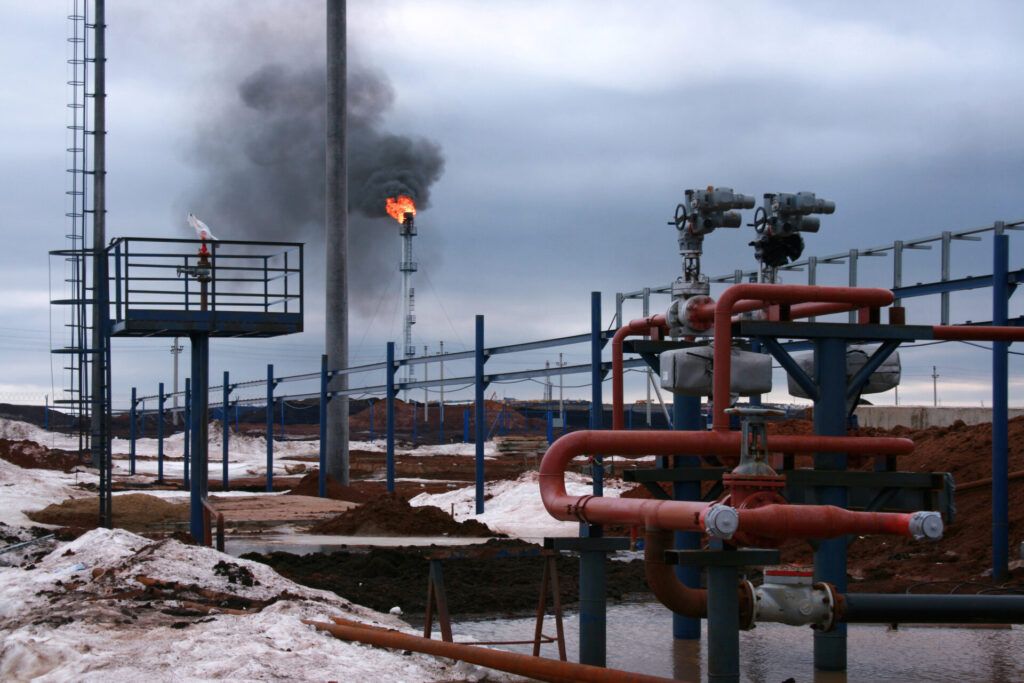Over-polluting and under-reporting: A look inside Russia’s dirty fossil fuel industry
By Bryson Wiese, Jake Garza Seymour | September 27, 2023
 Russian gas flaring. Credit: 2happy/Stockvault.net
Russian gas flaring. Credit: 2happy/Stockvault.net
Russia’s invasion of Ukraine inspired the G7 nations to cap the price of Russian oil, eroding the Kremlin’s profits from energy exports. But there is a reason beyond the invasion for global consumers to be wary of Russian oil and gas: greenhouse gas “emissions intensity,” or the amount of greenhouse gas emissions emitted per barrel of oil (or its equivalent) produced.
The combustion of oil and gas always produces greenhouse gases that contribute to global warming. However, not all oil and gas is equally polluting. Around a third of the lifecycle emissions come from “industry emissions,” meaning emissions from the stages leading up to end use (usually combustion). Industry emissions vary based on how a given quantity of oil or gas is produced, transported, and processed.
Using a 2022 emissions dataset covering two-thirds of the world’s oil and gas wells developed by the nonprofit Rocky Mountain Institute, we found that Russian oil and gas assets have an industry emissions intensity that is nearly double the global industry average (based on a 20-year time frame for assessing emissions’ impact).
The methane factor. Why are Russian oil and gas so dirty? Crucially, oil and gas operations emit not just carbon dioxide but also methane. Methane—the primary component in natural gas—is a highly potent greenhouse gas that is often captured and burned for energy. However, during production and transportation, some methane accidentally leaks into the atmosphere or is released intentionally as a waste product via flaring and venting. The UN Global Methane Assessment estimates that around a quarter of methane emissions from human activity come from the global oil and gas industry.
Russia’s weak methane regulations, leaky pipelines, and poorly managed operations are largely to blame for the country’s emissions-intensive oil and gas. Methane has more than 80 times the global warming potential of carbon dioxide during its first 20 years in the atmosphere and around 30 times the warming potential over 100 years. Given these climate consequences, many major oil and gas producers have sought to manage methane emissions by mitigating leaks and banning the venting of gas. Russia, however, is notorious for ignoring these best practices for methane management. Even before the Ukraine invasion, Russia’s gas giant Gazprom covered up major methane leaks despite pressure from the international community for greater transparency.
Russia ranks first in the world in total methane emissions from oil and gas operations. The average Russian oil and gas asset in 2022 was 75 percent more methane-intensive than the global average, based on the Rocky Mountain Institute dataset of oil and gas lifecycle emissions. Russia’s emissions intensity far exceeds that of most other major oil and gas producers, including the United States, Canada, Saudi Arabia, China, Qatar, and Norway.
Methane’s warming power makes the gas a key concern as governments and companies race to reach net zero emissions by 2050. The 2021 Global Methane Pledge, an initiative spearheaded by the United States and the European Union, has united countries representing 45 percent of the world’s human-caused methane emissions behind a pledge to cut emissions by at least 30 percent by 2030. Russia declined to participate.
Moscow’s dubious numbers. It is worth noting that just as there are concerns about the validity of Russia’s self-reported economic data—as Jeffrey Sonnenfeld and Steven Tian at the Yale School of Management (with whom we’ve collaborated) have highlighted—the Kremlin’s assessments of its own methane emissions similarly deserve scrutiny. The International Energy Agency’s independent estimate of Russian methane emissions in 2021 was about three times the total officially reported by Moscow to the United Nations Framework Convention on Climate Change.
Since Russia’s invasion of Ukraine in February 2022, Moscow’s numbers have become even less reliable. Yet there is reason to believe that Russian methane emissions have gotten worse. War-related production disruptions have led to reported spikes in flaring and venting events at idled Russian oil and gas wells. Meanwhile, decreased access to foreign capital and technology may have made it harder for Russian companies to monitor leaks and control emissions.
The Nord Stream pipeline leaks were a high-profile symbol of the war’s climate impacts and the energy sector’s contributions to emissions. Discovered on September 26, 2022, and attributed to a mysterious act of sabotage, the leaks in gas lines running from Russia to Germany under the Baltic Sea likely were the largest methane-emitting event on record. Estimates vary, but researchers say the leaks probably spewed between 100,000 and 400,000 tons of methane into the atmosphere. Although these leaks were comparable to the yearly emissions of around 9 million cars, they were equivalent to only around one to two days of the global fossil fuel industry’s normal methane emissions.
While the Nord Stream leaks lasted only a few weeks, the Kremlin’s emissions-intensive fossil fuels continue to disproportionately contribute to climate change. Sadly, the climate seems to be yet another in a long list of casualties from Putin’s war in Ukraine.
Editor’s note: The authors are indebted to William Casey King of Yale’s Jackson School of Global Affairs, for whose course they initially conducted this analysis, and to Jeffrey Sonnenfeld and Steven Tian of the Yale School of Management, who helped spark and guide their interest in Russia’s energy sector.
Together, we make the world safer.
The Bulletin elevates expert voices above the noise. But as an independent nonprofit organization, our operations depend on the support of readers like you. Help us continue to deliver quality journalism that holds leaders accountable. Your support of our work at any level is important. In return, we promise our coverage will be understandable, influential, vigilant, solution-oriented, and fair-minded. Together we can make a difference.
Keywords: Ukraine, emissions intensity, methane
Topics: Climate Change, Voices of Tomorrow
















It is not surprising to me that Russia does not follow best practices. This is not exactly their “forte’. On the other hand we have millions of abandoned gas wells in the U.S. and I am sure Russia does do. I don’t know how this compares to the methane produced by production. So the situation is a little more complex than meets the eye. MethaneSAT orbital data collection can detect leaks but I don’t know if it could do the whole country of Russia and the precision I do not know. An accurate total inventory natural and man made is… Read more »